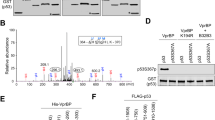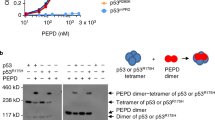Abstract
p63 shares considerable sequence identity with p53, especially in its DNA-binding, activation and tetramerization domains. When the upstream promoter is used for p63 expression, three major transactivation p63 (TAp63) isoforms (α, β and γ) are produced. p63 is also expressed from an alternate promoter located in intron 3, producing three major ΔNp63 isoforms. Recent studies demonstrated that p63 has the potential to function as a tumor suppressor or an oncoprotein. To further address this, we generated cell lines that inducibly express each TAp63 isoform. We showed that TAp63 isoforms are capable of inducing p53-responsive genes, inhibiting cell proliferation and promoting apoptosis. Interestingly, we discovered that both the activation domain (residues 1–59) and the proline-rich domain (residues 67–127) are required for TAp63 transcriptional activity. Likewise, TAp63β(ΔPRD), deleted of residues 60–133, possessed a greatly attenuated ability to induce endogenous target genes and promote apoptosis, but retained the ability to inhibit cell proliferation when expressed in stable, inducible cell lines. TAp63β(ΔPRD) also functioned as a dominant negative to wild-type p63β in a dose-dependent manner. Furthermore, the loss of function seen with deletion of the proline-rich domain was not due to a DNA-binding defect, as TAp63β(ΔPRD) was found to strongly bind endogenous promoters using chromatin immunoprecipitation assay. Finally, mutational analysis revealed that a PXXP motif at residues 124–127 contributes to the transcriptional activity of TAp63. Altogether, our findings suggest that TAp63 transcriptional activity can be regulated by modification(s) of, or protein interactions with, the p63 proline-rich domain.
This is a preview of subscription content, access via your institution
Access options
Subscribe to this journal
Receive 50 print issues and online access
$259.00 per year
only $5.18 per issue
Buy this article
- Purchase on Springer Link
- Instant access to full article PDF
Prices may be subject to local taxes which are calculated during checkout







Similar content being viewed by others
References
Attardi LD, Donehower LA . (2005). Probing p53 biological functions through the use of genetically engineered mouse models. Mutat Res 576: 4–21.
Baptiste N, Friedlander P, Chen X, Prives C . (2002). The proline-rich domain of p53 is required for cooperation with anti-neoplastic agents to promote apoptosis of tumor cells. Oncogene 21: 9–21.
Boyle JM, Greaves MJ, Roberts SA, Tricker K, Burt E, Varley JM et al. (1998). Chromosome instability is a predominant trait of fibroblasts from Li-Fraumeni families. Br J Cancer 77: 2181–2192.
Brunner HG, Hamel BC, Bokhoven Hans van . (2002). P63 gene mutations and human developmental syndromes. Am J Med Genet 112: 284–290.
Chen C, Okayama H . (1987). High-efficiency transformation of mammalian cells by plasmid DNA. Mol Cell Biol 7: 2745–2752.
Chen X, Ko LJ, Jayaraman L, Prives C . (1996). p53 levels, functional domains, and DNA damage determine the extent of the apoptotic response of tumor cells. Genes Dev 10: 2438–2451.
Dohn M, Zhang S, Chen X . (2001). p63alpha and DeltaNp63alpha can induce cell cycle arrest and apoptosis and differentially regulate p53 target genes. Oncogene 20: 3193–3205.
Edwards SJ, Hananeia L, Eccles MR, Zhang YF, Braithwaite AW . (2003). The proline-rich region of mouse p53 influences transactivation and apoptosis but is largely dispensable for these functions. Oncogene 22: 4517–4523.
El-Deiry WS, Harper JW, O'Connor PM, Velculescu VE, Canman CE, Jackman J et al. (1994). WAF1/CIP1 is induced in p53-mediated G1 arrest and apoptosis. Cancer Res 54: 1169–1174.
Flores ER, Sengupta S, Miller JB, Newman JJ, Bronson R, Crowley D et al. (2005). Tumor predisposition in mice mutant for p63 and p73: evidence for broader tumor suppressor functions for the p53 family. Cancer Cell 7: 363–373.
Ghioni P, Bolognese F, Duijf PHG, van Bokhoven H, Mantovani R, Guerrini L . (2002). Complex transcriptional effects of p63 isoforms: identification of novel activation and repression domains. Mol Cell Biol 22: 8659–8668.
Gressner O, Schilling T, Lorenz K, Schleithoff ES, Koch A, Schulze-Bergkamen H et al. (2005). TAp63α induces apoptosis by activating signaling via death receptors and mitochondria. EMBO J 24: 2458–2471.
Harms KL, Chen X . (2005). The C terminus of p53 family proteins is a cell fate determinant. Mol Cell Biol 25: 2014–2030.
Helton ES, Zhu J, Chen X . (2006). The unique NH2-terminally deleted ({delta}N) residues, the PXXP motif, and the PPXY motif are required for the transcriptional activity of the {delta}N variant of p63. J Biol Chem 281: 2533–2542.
King KE, Ponnamperuma RM, Yamashita T, Tokino T, Lee LA, Young MF et al. (2003). DeltaNp63alpha functions as both a positive and a negative transcriptional regulator and blocks in vitro differentiation of murine keratinocytes. Oncogene 22: 3635–3644.
Liu G, Chen X . (2002). The ferredoxin reductase gene is regulated by the p53 family and sensitizes cells to oxidative stress-induced apoptosis. Oncogene 21: 7195–7204.
Mills AA, Zheng B, Wang XJ, Vogel H, Roop DR, Bradley A . (1999). p63 is a p53 homologue required for limb and epidermal morphogenesis. Nature 398: 708–713.
Phang BH, Sabapathy K . (2007). The codon 72 polymorphism-specific effects of human p53 are absent in mouse cells: implications on generation of mouse models. Oncogene 26: 2964–2974.
Senoo M, Manis JP, Alt FW, McKeon F . (2004). p63 and p73 are not required for the development and p53-dependent apoptosis of T cells. Cancer Cell 6: 85–89.
Walker KK, Levine A . (1996). Identification of a novel p53 functional domain that is necessary for efficient growth suppression. Proc Natl Acad Sci USA 93: 15335–15340.
Willis A, Jung EJ, Wakefield T, Chen X . (2004). Mutant p53 exerts a dominant negative effect by preventing wild-type p53 from binding to the promoter of its target genes. Oncogene 23: 2330–2338.
Yang A, Kaghad M, Wang Y, Gillett E, Fleming MD, Dotsch V et al. (1998). p63, a p53 homolog at 3q27–29, encodes multiple products with transactivating, death-inducing, and dominant-negative activities. Mol Cell 2: 305–316.
Yang A, Schweitzer R, Sun D, Kaghad M, Walker N, Bronson RT et al. (1999). p63 is essential for regenerative proliferation in limb, craniofacial and epithelial development. Nature 398: 714–718.
Zhu J, Jiang J, Zhou W, Zhu K, Chen X . (1999). Differential regulation of cellular target genes by p53 devoid of the PXXP motifs with impaired apoptotic activity. Oncogene 18: 2149–2155.
Acknowledgements
We thank Jianhui Zhu for assistance in generating some of the stable cell lines used in preparation of this manuscript. This study is supported in part by National Institute of Health grant (CA102188).
Author information
Authors and Affiliations
Corresponding author
Rights and permissions
About this article
Cite this article
Helton, E., Zhang, J. & Chen, X. The proline-rich domain in p63 is necessary for the transcriptional and apoptosis-inducing activities of TAp63. Oncogene 27, 2843–2850 (2008). https://doi.org/10.1038/sj.onc.1210948
Received:
Revised:
Accepted:
Published:
Issue Date:
DOI: https://doi.org/10.1038/sj.onc.1210948



